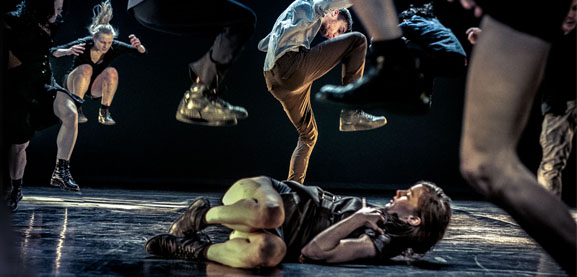
INSIGHTS | Our Young Blogger Reviews Ultima Vez
min read
Share
By Kieran Wyatt (Grand Young Blogger)
I have a jittery relationship with contemporary dance. My sister is a dancer and many of my friends, unusually, have an affinity with the contemporary dance circuit. As a romantic, a lover of narrative, I sometimes find it difficult to connect with a long piece of contemporary dance. However, there is a kind of freedom in seeing a collection of meticulous physical movements and watching them in a completely different way to the person sitting next to you. Also, as a person with little actual knowledge of contemporary dance I do not have the baggage, good or bad, when coming to see a show like What the Body Does Not Remember which appears to have such a reputation.
First performed in 1987 and originally choreographed by Wim Vandekeybus, What the Body Does Not Remember is a striking example of dance, in general. Striking is the word and whether the strike is always welcome, always understandable is arguable. I am not going to lie and say that I enjoyed every second of What the Body Does Not Remember but, there were moments of brilliance and I was never wishing that it would end. At points it’s a hard nut to crack and the long stretches of undeniably well-rehearsed yet undeniably repetitive dance can grate.
There is a lot to be impressed by in Vanderkeybus’ work. What the Body Does Not Remember features four main chunks, as far as I could see, each of which play on different themes but also incorporate the overriding ideas of duality and opposition. Music also plays a large part in bringing the show to life. One of my favourite moments in the performance was near the climax, when the music simply stops and the furiously moving and profusely sweating dancers carry on their shots and twists. It is a strange moment, which could be seen as funny, a moment which highlights the precision of the performers and the ridiculousness of such movements when taken out of the emotion of the music.
Personally, I would have enjoyed more moments which looked more at the form rather than exploring external themes of sex and dominance. Despite this I did enjoy other individual moments which picked at said themes. The segment which focused on a, for want of a better phrase, that stick in the mud pose, was wrenching to watch and totally engaging for the space of time it occupied the stage. The Grand’s stage was a grand and rather large space to showcase the performance and I am very glad that I was able to see such a show in such a theatrical environment.






















